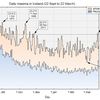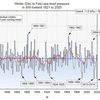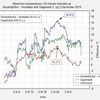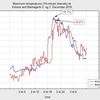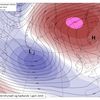9.12.2014 | 22:18
An unusually warm November in Iceland
The year 2014 will be one of the warmest ever measured in Iceland. It has a real chance of becoming the warmest of all along the northern and eastern coasts. The odds of a new temperature record is lower in other areas.
November became the fourth month of the year to exhibit an overall anomaly larger than +2 degrees C [the others are: January, June and September]. The table shows the November temperatures and anomalies for selected stations all over Iceland. The month was the warmest ever in Grímsey off the N-coast, measurements have been done there for 140 years. It was also the warmest at Teigarhorn at the Eastern coast, where measurements have been made for 142 years. The station Árnes in the Southern inland also shows its highest November value ever, but as the station has not been located at the same farm throughout the period the rank is slightly more uncertain than at the other stations. The same uncertainty also applies for the rank at the station Bolungarvík at the extreme Northwest tip of the country.
| stöđ | mean | anomaly 1961-1990 | rank | of | anomaly 2004-2013 |
| Reykjavík | 5,5 | 4,4 | 2 | 144 | 3,2 |
| Stykkishólmur | 4,3 | 3,4 | 3 | 169 | 2,7 |
| Bolungarvík | 3,7 | 2,9 | 7 til 8 | 117 | 2,8 |
| Grímsey | 4,3 | 3,7 | 1 | 140 | 2,9 |
| Akureyri | 3,4 | 3,7 | 6 | 133 | 3,1 |
| Egilsstađir | 3,9 | 4,6 | 3 | 60 | 2,2 |
| Dalatangi | 5,7 | 3,9 | 2 | 76 | 3,0 |
| Teigarhorn | 5,5 | 4,1 | 1 | 142 | 3,3 |
| Höfn í Hornaf. | 5,8 | 3,9 | |||
| Stórhöfđi | 6,2 | 3,8 | 2 | 138 | 2,7 |
| Hveravellir | -0,3 | 4,5 | 2 | 50 | 3,1 |
| Árnes | 4,6 | 4,8 | 1 | 134 | 3,7 |
Bloggar | Slóđ | Facebook | Athugasemdir (0)
2.7.2014 | 15:58
A remarkably warm June in Iceland
The first six months of 2014 have been very warm in Iceland, overall the second warmest to fifth warmest of all time at stations with long measurement series. At many stations the warm anomalies have culminated in June.
In Stykkishólmur in W-Iceland the temperature records go back to 1845. June 2014 ranks as the warmest of the whole period. In Akureyri in the north (records back to 1882) it is the second warmest, exceeded by June 1933 with the closest possible margin, 0.1°C. The average temperature in Reykjavík in June ranks at number four (records back to 1871).
The average temperature at the station Torfur located inland in a valley near Akureyri in the north was 12.7°C. This is equal to the highest monthly average June temperature ever recorded in Iceland. The earlier instance of 12.7°C (Húsavík 1953) has been considered to be dubious because it was 0.4 degrees higher than the second highest June average in the country (Akureyri 12.3, June 1933).
This was also the warmest June ever recorded in Grímsey, an island at the Arctic Circle off the North coast of Iceland. The new record is 0.7°C higher than the earlier maximum and also almost four degrees higher than the 1961 to 1990 June average at the station. This must be considered remarkable at an oceanic site as Grímsey. The sea surface temperatures around Grímsey have also been very high. During the last week of the month the ecmwf sea surface temperature analysis showed an area near Grímsey with an anomaly of +6°C. This area was also very warm last June (2013) and highlights the general anomalous oceanic conditions off the North coast of Iceland prevailing during the last 15 years or so. Even so – this great culmination of warmth is unexpected.
June was generally on the wet side in the Western part of the country, especially in Reykjavík where the month was the second wettest in a series that extends back to 1885 – with a large gap from 1907 to 1919.
This was nominally the calmest month of June in the country since 1963 – but the confidence in the homongeneity of the wind speed series low when it comes to a close absolute ranking of mean speeds over a long period.
In spite of this exceptional warm conditions the absolute maximum temperature recorded in Iceland during June 2014 was "only" 23.1°C. But at the same time the temperature in the inhabited areas of the country never dropped below freezing. In the recent record (comparable station network density) this also happened in June 2003 - but before that only in June 1933 (slightly less dense network), June 1909 and 1880. The station density in 1909 and 1880 was much lower than later so these years are not quite comparable to the other three (1933, 2003 and 2014) in this respect.
Bloggar | Breytt s.d. kl. 16:12 | Slóđ | Facebook | Athugasemdir (0)
3.2.2014 | 18:10
A January without freezing temperatures
The absolute minimum temperature at Vattarnes in the Eastern Fjords area in Iceland remained above 0.0°C during the whole month of January 2014. This is the first time that this happens at an Icelandic weather station. The final minimum of the month was 0.4 °C (measured at 10 and 14 utc 14 January).
At the nearby island station at Seley (less than 10 km distant) the January minimum was 0.0°C. A few other stations in the country registered their highest January minima ever.
On the whole the temperature variability in Iceland during this month was unusually small. The absolute maximum temperature in the entire country was only 10.1°C, the lowest since 1994 and the lowest minimum in the inhabited areas was -16.4°C, the highest in the books since 1990. The total range (maximum - minimum) was thus only 26.5°C. It was the same in January 1990 but one has to go back to January 1947 to find a lower value. Then the station density was much lower than now and comparison is open to question.
There were very few observations in the highlands until about 1995. In most months the lowest temperature in the country is observed at the highland stations - this time -19,0°C at the Brúarjökull glacier. This is about 6°C higher than the average of the last 10 years.
The absolute temperature range in Reykjavík has only once been as small in January as now (in 1987) and it has by a large margin never been as small in Akureyri (since reliable maximum registrations began there in 1935).
Overall January was warm in Iceland. In the country as a whole it is about the 10th warmest of the period 1874 to 2014, but at some of the stations in the East - both coast and inland it was the second warmest of all time. This was the case at Teigarhorn which has continuous observations back to 1873, only January 1947 was warmer than now.
In Reykjavík it was the 12th warmest (starting in 1871) and 11th warmest in Akureyri (starting in 1882).
The Vattarnes automatic station is located on a low promontory at the mouth of Reyđarfjörđur, the largest fjord in Eastern Iceland:
Vattarnes 64°56.22'N; 13°41.086'W; 5.0 m.a.s.l. began in 2000
A synoptic station was in operation there during 1931 to 1943 (no minimum thermometer).
A web search for the name will return some photographs (mainly the lighthouse) and a map search should find the Vattarnes promontory.
Bloggar | Breytt s.d. kl. 21:14 | Slóđ | Facebook | Athugasemdir (0)
4.8.2013 | 00:43
A new highland maximum temperature record in Iceland
Iceland was favored by high temperatures during the last part of July. The maximum temperature in the country exceeded 20°C for 14 days in a row. The maximum length of a period with maximum above 20 degrees is 23 days (recorded last year 2012) but warm periods (in this particular sense) of two weeks or more are unusual.
The highest temperature in the country in July was recorded on the 21st, 26,4°C at the station Ásbyrgi in the Jökulsá national park in the northeast.
The headline news of the month, however, was the 25,9°C measured in Veiđivatnahraun in the southern highlands on 24 July. This is the highest temperature ever recorded in Iceland at a station above 400 m a.s.l. The Veiđivatnahraun station is located at the height of 647 m above sea level in a semi-desert area. At the time of observation the relative humidity was extremely low, only 13%.
The station has been in operation since 1993. There were practically no meteorological observations in the highland until the lone all-season manned station was established at Hveravellir in the central highlands in 1965 (640 m a.s.l.). After 1993 an increasingly dense network has been established, mainly at the effort of the Landsvirkjun (national power company).
The earlier maximum temperature registered in the highlands was only exceeded by 0,1°C, 25,8°C , measured at Upptyppingar - in the northeastern highlands.
A table of monthly temperature maximum records in the Icelandic highlands:
| id | yr | mon | day | hr | max °C | station name | |
| 4019 | 2010 | 1 | 25 | 17 | 12,5 | Upptyppingar | |
| 4019 | 2006 | 2 | 21 | 18 | 11,1 | Upptyppingar | |
| 4019 | 2000 | 3 | 28 | 13 | 13,2 | Upptyppingar | |
| 4019 | 2007 | 4 | 30 | 17 | 18,0 | Upptyppingar | |
| 4019 | 2007 | 4 | 30 | 18 | 18,0 | Upptyppingar | |
| 4019 | 2000 | 5 | 11 | 13 | 19,0 | Upptyppingar | |
| 4019 | 2000 | 6 | 30 | 14 | 24,1 | Upptyppingar | |
| 6657 | 2013 | 7 | 24 | 15 | 25,9 | Veiđivatnahraun | |
| 4019 | 2004 | 8 | 13 | 18 | 25,8 | Upptyppingar | |
| 5970 | 2009 | 9 | 13 | 9 | 19,8 | Hallsteinsdalsvarp | |
| 5970 | 2009 | 9 | 13 | 11 | 19,8 | Hallsteinsdalsvarp | |
| 5943 | 2003 | 10 | 26 | 13 | 17,4 | Eyjabakkar | |
| 5943 | 1999 | 11 | 19 | 10 | 16,8 | Eyjabakkar | |
| 5943 | 2010 | 12 | 15 | 1 | 12,5 | Eyjabakkar |
All of the station names are googleable.
This is an extract of the icelandic version:
http://trj.blog.is/blog/trj/entry/1307122/
hungurdiskar blog:
Bloggar | Breytt s.d. kl. 00:48 | Slóđ | Facebook | Athugasemdir (0)
14.5.2013 | 23:25
A new absolute minimum record for May in Iceland
On 2 May the automatic weather station at Brúarjökull registered a minimum temperature of -21.7°C. This is the lowest temperature ever measured in Iceland in May. However, it should be kept in mind, that this station has only been in place since 2005 and it is one of the coldest measuring sites in the country.
This cold spell is probably the most intensive one in May throughout the period of automatic observations in Iceland. The network was established in 1993 to 1998, becoming more dense since. New station minimum temperature records for May were registered at the majority of the automatic stations during the present cold spell.
The number of manned synoptic stations measuring temperature has decreased rapidly after 2004. A few of the remaining stations registered new minima for May during the present cold spell. These stations, except one, have only been in operation since 1988 or later. At the older synoptic stations the present minima did not exceed earlier records, except at one station. Most of these originate in a cold spell in early May 1982. One station which has been in operation since 1924 (not quite continuously, however) registered a new absolute record on 2 May this year.
The present cold spell seems to have been the most intensive in May in Iceland since at least 1982. Nobody knows how low the temperature at Brúarjökul was at that time.
On the measurements of minimum temperature in Iceland
At the “manual” stations the minima are measured with a traditional alcohol minimum thermometer. Readings are made two times per day, at 9 utc and at 18 utc The lower of the two readings becomes the minimum of the day. In the middle of winter the daily minimum is quite often recorded at 18 hrs, but during the other seasons most often at 9 in the morning.
At the automatic stations the minimum of the day is the lowest 2-minute average temperature during the 24 hour period from 00:01 to 24:00. At most of the automatic stations the temperature is registered every 10-minutes (a 2 minute mean) along with the highest and lowest 2-minute averages during the preceding 10 minutes. The automatic instruments have a somewhat faster response time compared to the traditional minimum thermometers placed in thermometer screens. In calm situations fluctuations of the minimum temperature are common as the temperature inversion nearest to the ground strengthens and mixes at irregular intervals.
This fluctuating behavior of the minimum temperature has not been examined systematically in Iceland.
The validity of the new record
The old record May minimum in Iceland was registered at the manned station Möđrudalur on 1 May 1977, -17.4°C. The new record is more than 3 degrees C lower than this and must be considered unquestionable even though the new record is made at an automatic station with different attributes than the traditional measurement.
The Brúarjökull station is located at 845 m above sea level at the snout of a very large and flat outlet glacier of the icecap Vatnajökull. This is well within the highlands of Iceland and almost 400 meters above the location of the earlier record station Möđrudalur.
The first all-year highland station in Iceland was established in 1965 and a few others were in drift for a few years or seasons until the advent of automatic stations. It has been customary to distinguish between the highland stations on one hand and the stations in the inhabited areas on the other in the listing of weather records. However, regarding the minima, the inhabited stations in the very flat northeastern highlands have been almost on par with the higher level highland stations proper during winter. The earlier May minimum record had thus persisted for 36 years even though many automatic stations have been in operation at higher levels for more than 15 years.
A new absolute minimum for the inhabited stations was also registered at the same hour as the new whole-country record. The minimum at the automatic station at Grímstađir (another northeastern inland station) plunged down to -17.6°C, 0.2°C lower than the old record.
The automatic station at Grímsstađir is new, however, established last autumn only. There still are ongoing measurements at the old manual station there. The in-screen minimum thermometer registered “only” -14.5°C on the morning of 2 May. The distance between the two stations is less than 100 meters.
The registrations at the new automatic station at Grímsstađir have not been compared to the manual registration in a systematic manner and a post-installation calibration has not been made. Until that is done the new record will not be formally confirmed.
Bloggar | Slóđ | Facebook | Athugasemdir (0)
4.9.2012 | 19:52
August in Iceland
August was a very warm month in the northern, western and southwestern parts of Iceland. In Reykjavík it was the fourth warmest since the official beginning of observations in 1871. August of 2003, 2004 and 1880 were slightly warmer. The temperature was above average in the whole country but not much above in the southeast.
The highest temperature of the month was recorded at Eskifjörđur in the Eastern Fjords area on the 9th, 28.0 degrees C. This is the highest temperature measured in Iceland since 2008. The last week of the month was rather cold with overnight freezing temperatures at many inland locations. The lowest minimum of the month was -5.3°C registered at Brúsastađir in a valley in the north.
It is unusual that the maximum temperature of the country stays above 20 degrees C for more than a few days in a row. But this summer saw a new record in this respect, the period from 27 July to 19 August had an unbroken chain of country maxima above or equal to 20 degrees. During the warm period the overnight low temperatures were also unusually high and the minima close to being record high.
The precipitation was at average in Reykjavík but in most parts of the country it was drier than usual. In Akureyri the total of the month was only 8.4 mm, the driest August since 1960. The sunshine hours in Reykjavík were close to average but Akureyri has only once enjoyed more sunshine in August since the beginning of registration in 1928.
The first eight months of the year have been unusually warm in Iceland. This period of the year has only once been warmer in Stykkishólmur (in the west), that was in 2003. The record goes back to 1846.
Bloggar | Breytt s.d. kl. 19:53 | Slóđ | Facebook | Athugasemdir (0)
2.8.2012 | 22:18
July - a warm and sunny month in Iceland
July was both warm and sunny in most of Iceland. A small part of the East had temperatures just above average, in most other areas the month was one of the 10 warmest months of July.
In Vestmannaeyjar off the southern coast this July was the warmest since the station was moved to its present location in 1921. Temperature measurements, however, were done at another location at a lower elevation prior to that from 1877. And during 1869 to 1877 (unofficial) measurements were made at the third location. Older measurements exist for Vestmannaeyjar (during the 1840s) but they were clearly contaminated by the exposure of sunlight during summer. Since 2003, measurements have been made at two locations allowing the calculation of a site adjusted series back to 1877 (and unofficially back to 1869). This shows that July 1880 was probably about equally as warm as July now (2012).
The sun has been shining in the west and north as never before. The number of bright sunshine hours was well above average in Reykjavík and within 1 hour of the July record in Akureyri. But a look at the sum of the last three months reveals an exceptional situation at both stations. This period is the sunniest at both stations since the beginning of registration, in Reykjavík in 1911 and in 1928 in Akureyri. In Akureyri the old record (from 1939) was exceeded by 120 hours of sunshine and the total for the first seven months of the year is already close to the average annual total.
The precipitation in July was below average in all districts but not quite so as in May and June.
Even though the weather has been warm, days with maximum temperature above 20 deg C have been few and the Reykjavík absolute maximum of the summer is still below 19 deg C.
The month also brought the lowest July pressure ever recorded in Iceland (see a separate entry). Even so, the average monthly pressure was above the long-term mean.
Bloggar | Slóđ | Facebook | Athugasemdir (0)
23.7.2012 | 17:12
A new low pressure record for July in Iceland
A remarkably deep low developed to the southwest of Iceland on 19 and 20 July 2012. According to the analysis of the ECMWF the central pressure in the low dropped to 966 hPa. This is amongst the lowest values ever observed in the North Atlantic in July.
After the low reached its maximum intensity it moved towards Iceland and filled gradually. In the evening of Sunday 22 July the pressure was at minimum near the south coast of Iceland. The lowest mercury barometer reading was 972.8 hPa, first at Vestmannaeyjar at 21 pm and then again at Kirkjubćjarklaustur 6 hours later. The lowest value at an automatic station was reached in Vestmannaeyjar during an extended period of one hour, 21:30 to 22:30, 972.4 hPa.
The pressure in Iceland has only on three occasions dropped down to 975 hPa or lower in the entire record extending back to the 1820s. These cases were 974.1 hPa in Stykkishólmur on 18 July 1901, 974.3 hPa in Stykkishólmur on 19 July 1923 and 975.0 hPa in Reykjavík 11 July 1912. It should be kept in mind that even the pressure was recorded at a few stations all over the country during the period from 1874 onwards, longer intervals passed between readings than now. Three readings per day were typical, but eight readings have been made at most of the barometric stations since the mid-1940s.
The low has brought rain to most of the country. Some parts have been experiencing an unusual drought since May. If the rain will alleviate the low water levels in the non-groundwater-fed rivers remains to be seen.
The country more or less escaped the high winds associated with the low as the centre passed just south of the country. The wind was strongest to the south of the low, as well as in the Greenland Strait (Denmark Strait) to the northwest of Iceland. The strongest gust associated with the low was measured 39.5 m/s at the station Steinar at the southern coast.
Bloggar | Slóđ | Facebook | Athugasemdir (0)
13.7.2012 | 10:58
Temperatures in Iceland - as originally published
Due to the recent confusion regarding the Icelandic temperature series I have decided to post a list of monthly temperature averages as they were originally publised in the Icelandic and Danish yearbooks prior to 1960. Later original published data are available online at the website of the Icelandic Met. Office (IMO) (see the supplementary information attachment).
This post consists of three files, the data list (original_pub_temperature_values.txt), a station list (original_pub_temperature_stat_info.txt) and supplementary information (original_pub_temperature_values_suppl_info.txt) on the data format etc. Please feel free to download the attachments (viđhengi) at the end of this post.
The IMO has calculated series with some appropriate adjustments for each individual station. The IMO generally uses the version with adjustments made on pre-1961 data rather than the present dataset. These data are available on request (trausti@vedur.is) for individual stations but the whole dataset will be made available later.
It must, however, be emphasized that the adjustments will change in the future as more information on station history and inter-station comparison will be added. One should therefore expect changes in the adjusted dataset through time.
The present dataset (original_pub_temperature_values.txt) will remain static, except for the addition of values from individual stations during the pre-1920 period which have not yet been digitized. Readers should note that these values are available in the Danish yearbooks (see a link in the supplementary information attachment).
Please feel free to comment and if you find any errors a note will be appreciated either by filling out the comment form (see below) or by sending your questions or notes to: trj@simnet.is
The comment form [The "athugasemdir" link near the bottom of the text] is in Icelandic, but most of it should be transparent to English readers. When you submit the comment you will be prompted for your name, e-mail (netfang - essential), vefslóđ (web link - not essential) and a question: What is the sum of two numbers? Just add the two numbers (within a short period of time) write the sum in the box and resubmit. This is for the spam-filter (ruslpóstsvörn).
[Dec. 4, 2012 The comment option has a timeout - please direct queries to trj@simnet.is}
Bloggar | Breytt 4.12.2012 kl. 16:55 | Slóđ | Facebook | Athugasemdir (0)
3.7.2012 | 15:23
June 2012 in Iceland
June was very sunny in both western and northern Iceland. The total number of bright sunshine hours at Akureyri and Reykjavík were close to the all-time records. The total number of sunshine hours at these two stations in May and June as a whole is unprecedented.
It was a very dry month in most of the country. Parts of the west and northwest experienced the driest June (or even any month) ever. Stykkishólmur has the longest precipitation series in the country, the precipitation observations began in October 1856. June 2012 is the driest month on record, with the total being only 0.6 mm of rain. In some places in the northwest the earth is very dry and the vegetation suffers. A few farms are almost without clean running water and depend on tanking for water consumption. However, the main part of the winter had much precipitation in the area so there is some snow still surviving in the mountains feeding rivers and groundwater.
June was warm in the south and west, amongst the ten warmest on record in the Reykjavík area, but in the north and east it the temperature was slightly below average as northeasterly winds were prevalent.
The highest temperature in June was registered at the stations Hella and Árnes in the southern lowland on the 2nd, 22.8 degrees C. The lowest temperature of the month was registered at Gagnheiđi - a mountain in the east on the 5th, -5.7 deg C. The lowest temperature in inhabited areas was registered at Brú in the eastern inland, -4.4 deg C on the 13th. There were only ten nights entirely frost-free in the inhabited areas.
The full official report is available (in Icelandic) on the Icelandic Met. Office web.
Bloggar | Slóđ | Facebook | Athugasemdir (0)
Um bloggiđ
Iceland Weather blog
Nýjustu fćrslur
- Unusually high temperatures
- Unusually high sea level pressure
- Sea level pressure: Unusually low in Iceland this winter
- A new national maximum temperature record for December
- A new sea level pressure record for June in Iceland
- An unusually warm April in Iceland
- A new October high pressure record in Iceland
- A new absolute September maximum temperature record in Iceland
Heimsóknir
Flettingar
- Í dag (16.9.): 0
- Sl. sólarhring:
- Sl. viku: 3
- Frá upphafi: 0
Annađ
- Innlit í dag: 0
- Innlit sl. viku: 3
- Gestir í dag: 0
- IP-tölur í dag: 0
Uppfćrt á 3 mín. fresti.
Skýringar

 original_pub_temperature_values.txt
original_pub_temperature_values.txt
 hoskibui
hoskibui
 svatli
svatli
